DNSFilter vs
Cisco Umbrella
Escape High Costs and Complex Tools with DNSFilter, a Cisco Umbrella Alternative
Tired of Cisco’s rising prices, clunky UI, slow support, and forced migrations? So were thousands of organizations who switched to DNSFilter. We give you faster protection, easier management, real support and no hidden surprises — all deployed in an afternoon.
Limited time offer: DNSFilter is giving Cisco Umbrella customers up to 6 months of content filtering for free when they make the switch to DNSFilter. Valid through December 31, 2025*. Contact our sales team today!
Stop threats faster — DNSFilter blocks malicious domains an average 10 days sooner than competitors that rely on third party threat feeds.
Simplify deployment — Customers report DNSFilter’s setup takes minutes, with intuitive policy management built in.
Avoid costly errors — Cisco Umbrella customers often encounter configuration issues with IP filtering and SSL decryption — errors that take days to resolve.
Real support, real fast — While Cisco struggles with slow or unresponsive support, DNSFilter delivers fast, knowledgeable help whenever needed.
Continuous innovation — DNSFilter is actively investing in faster filtering, better reporting, and smarter protection — unlike Cisco’s stagnant platform.
Get the Full Cisco Umbrella Head-to-Head Report
DNSFilter vs. Cisco Umbrella
4 out of 5 customers who made the switch from Cisco Umbrella to DNSFilter say it's easier to use, easier to manage, and delivers better support.
Cisco Umbrella Roaming Client vs. DNSFilter Roaming Clients
Roaming Clients give you the ability to deploy AI-powered threat blocking and content filtering to your endpoints, and it’s a useful tool if you’re interested in more granular reporting.
Cisco Umbrella's Roaming Clients reached End-of-Life April 2025, requiring Umbrella customers to migrate and re-implement their Roaming Clients using the Umbrella Roaming module in Cisco Secure Client. Avoid the complexity, downtime, and resource drain of Cisco’s next forced migration. Choose DNSFilter—the easy-from-the-start solution for smarter, seamless endpoint-based threat and content filtering.
Learn more about
Cisco Umbrella Roaming Client End-of-Life:
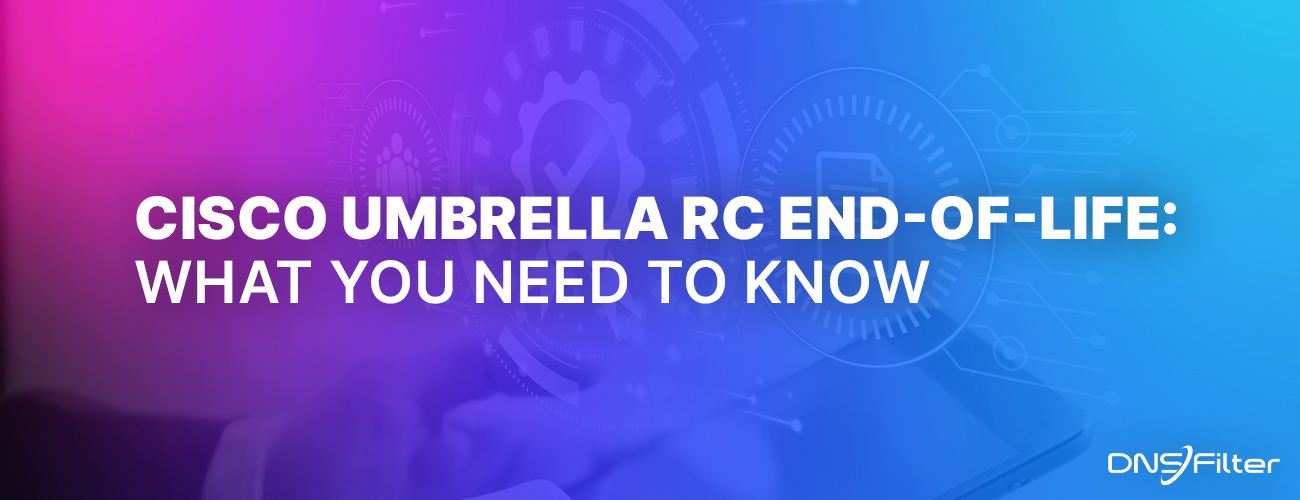
Cisco Umbrella RC End-of-Life: What You Need to Know
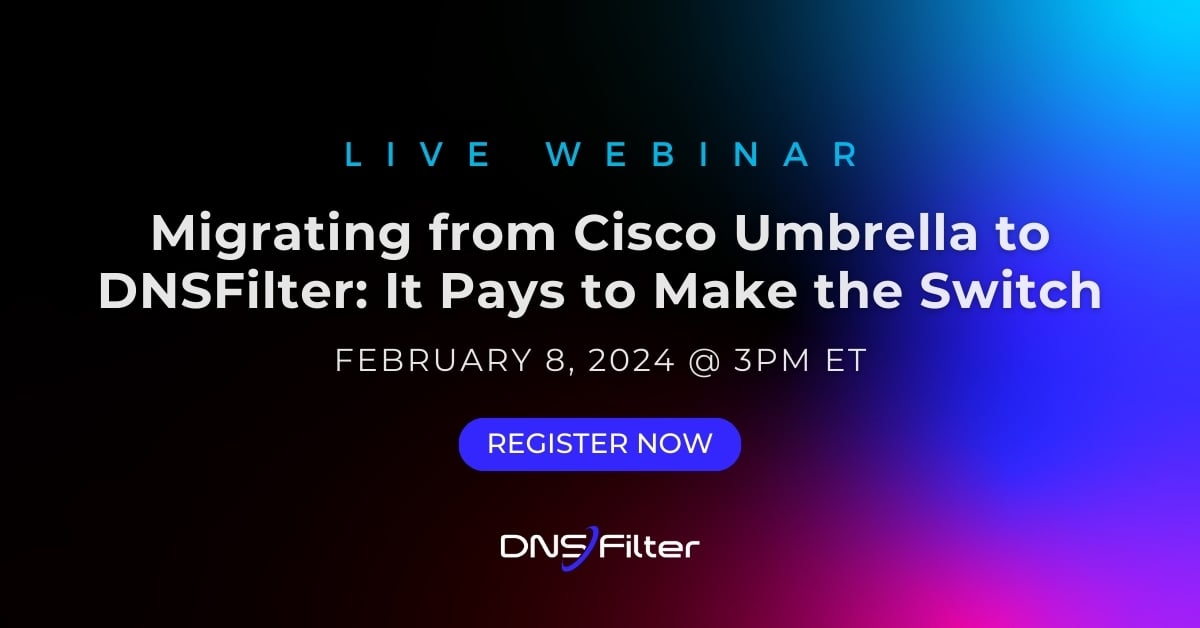
Migrating from Cisco Umbrella to DNSFilter: It Pays to Make the Switch
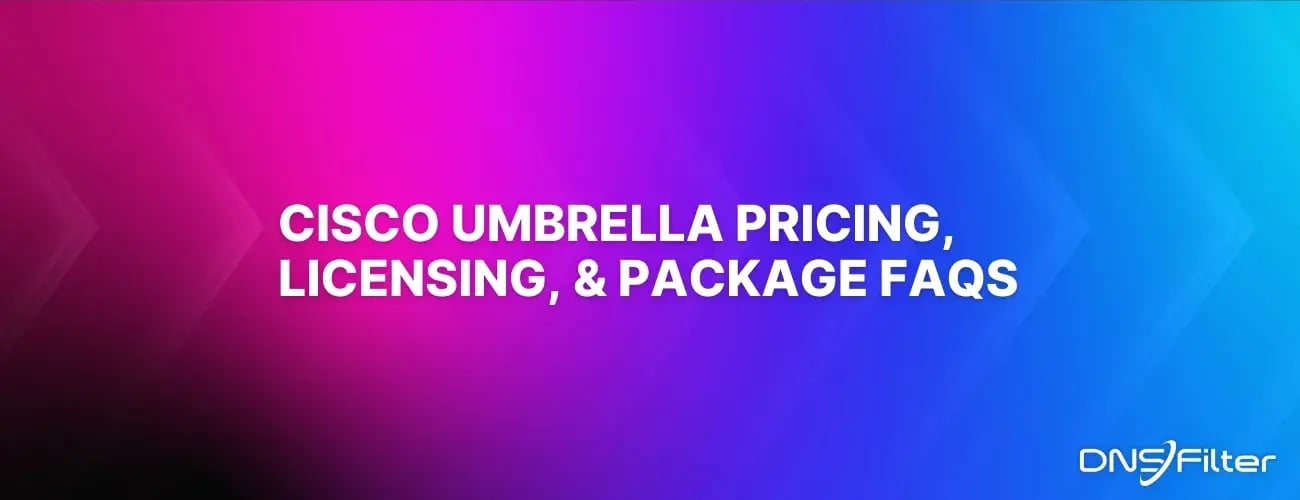
Cisco Umbrella Pricing, Licensing, & Package FAQs
As millions of Cisco users prepare for Umbrella Roaming Client's end-of-life, what are your options?
Frequently Asked Questions
What is Cisco Umbrella?
Cisco Umbrella (previously OpenDNS) is a cloud-based DNS security solution, similar to DNSFilter. Umbrella provides basic web filtering, and integrations with platforms like Connectwise PSA and Amazon S3 for log export. DNSFilter matches these capabilities, offering log export options and integrations with six of the leading PSA platforms, including Connectwise.
However, Cisco Umbrella is not as effective at threat blocking as DNSFilter, which leverages AI-based detection to identify new malicious domains an average of 10 days sooner than competitors. Cisco Umbrella is harder to deploy and has not continued to update or invest in their product over time—really since they acquired OpenDNS.
Is OpenDNS the same as Cisco Umbrella?
Cisco Umbrella began as OpenDNS in 2008 as the first cloud-based protective DNS service. OpenDNS was purchased by Cisco in 2014. The name OpenDNS is now used for free filtering for home and families. It has different settings to block threats and/or adult categories compared to its Cisco Umbrella counterpart. In 2022, Cisco announced that while OpenDNS will remain free for home use (with limited features), old OpenDNS MSP programs reached end-of-life.
What is the pricing for Cisco Umbrella?
Cisco Umbrella does not have public-facing pricing. Learn more about Cisco Umbrella Pricing, Licensing, and Package FAQs.
What challenges do Cisco Umbrella customers encounter?
When a customer signs up for Cisco Umbrella, they face a slew of challenges. The first, and the one we hear repeatedly from our customers and prospects, is the total lack of support for the product. When you have an issue with Cisco Umbrella, it can be nearly impossible to get a hold of someone. This leads to impacted Cisco customers without any DNS security for large chunks of time.
The Cisco UI/UX is not intuitive and takes a more technical individual to implement the setup. This means you might need senior technical resources to take on a deployment they don’t have time for, as opposed to passing it over to a more junior engineer. Not to mention, within the Cisco Umbrella UI it is difficult to find things and some things are in multiple places, making it even harder to maintain a sense of where things are and where you can update them.
Other common Cisco challenges customers endure are long contracts that lock you in, no investment or innovation on the product (the UI has not evolved very much since its OpenDNS days), and a slower anycast network.
What is the biggest difference between DNSFilter and Cisco Umbrella?
The biggest difference between DNSFilter and Cisco Umbrella is the efficacy of DNSFilter's domain classification, which relies on our ML Webshrinker. Further, DNSFilter has an approachable company culture, and customers are involved in our decision making process of which features to implement. We have a transparent pricing model displayed on our public website and our support team is incredibly responsive compared to Cisco's. DNSFilter also offers more whitelabeling options for MSPs.
What does it mean to me that Cisco Umbrella has end-of-lifed their roaming clients?
As of April 2025, Cisco Umbrella Roaming Clients officially reached end of life. Customers who haven’t already migrated will need to migrate to the Umbrella Roaming module in Cisco Secure Client—or risk operating unsupported clients with no access to updates, no compatibility guarantees with new operating systems, and increased security risks. Read more about this change and how to migrate to DNSFilter.
Trusted by Enterprise, SMBs, and MSPs
Learn more in our DNSFilter vs. Cisco Umbrella case studies.
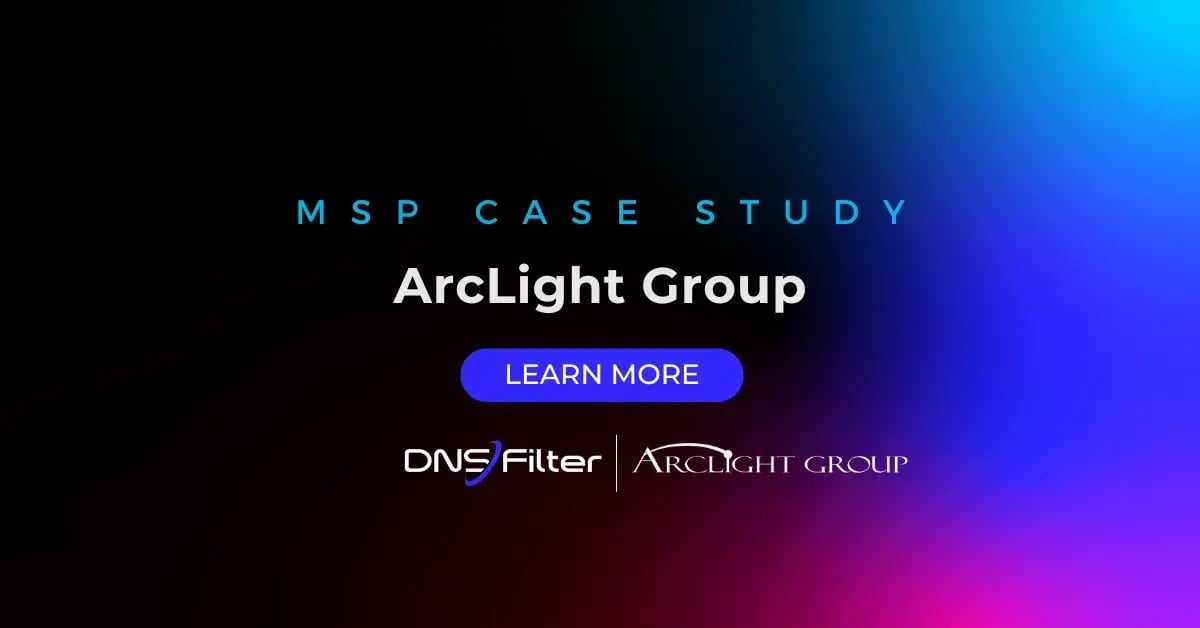
ArcLight Group Case Study
“We'd tried the Cisco Umbrella way and they just were not overly friendly to the MSP market at the time. They had some really bad or unwieldy requirements on limits and so on, and we were just trying to get started. So, we shopped around, we tried them for a while and then we landed on DNSFilter.”
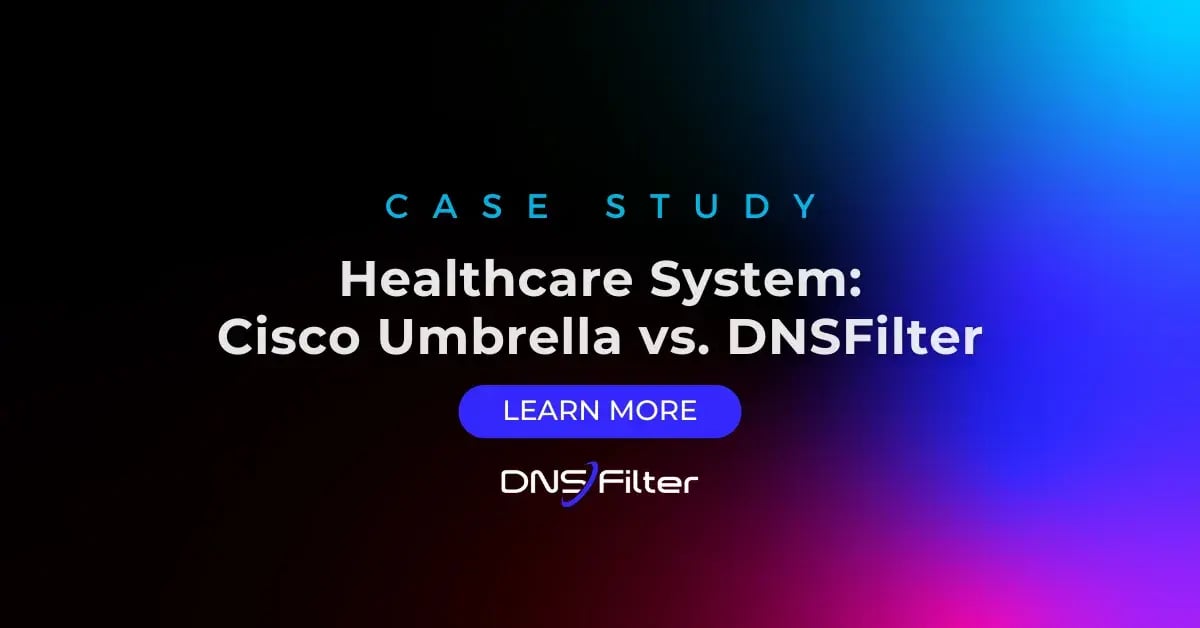
Healthcare System Switched to DNSFilter from Cisco Umbrella
"The impending renewal of their Cisco Umbrella contract, due roughly two months from the initial contact, created a sense of urgency to find an alternative solution that could meet their needs more cost-effectively."
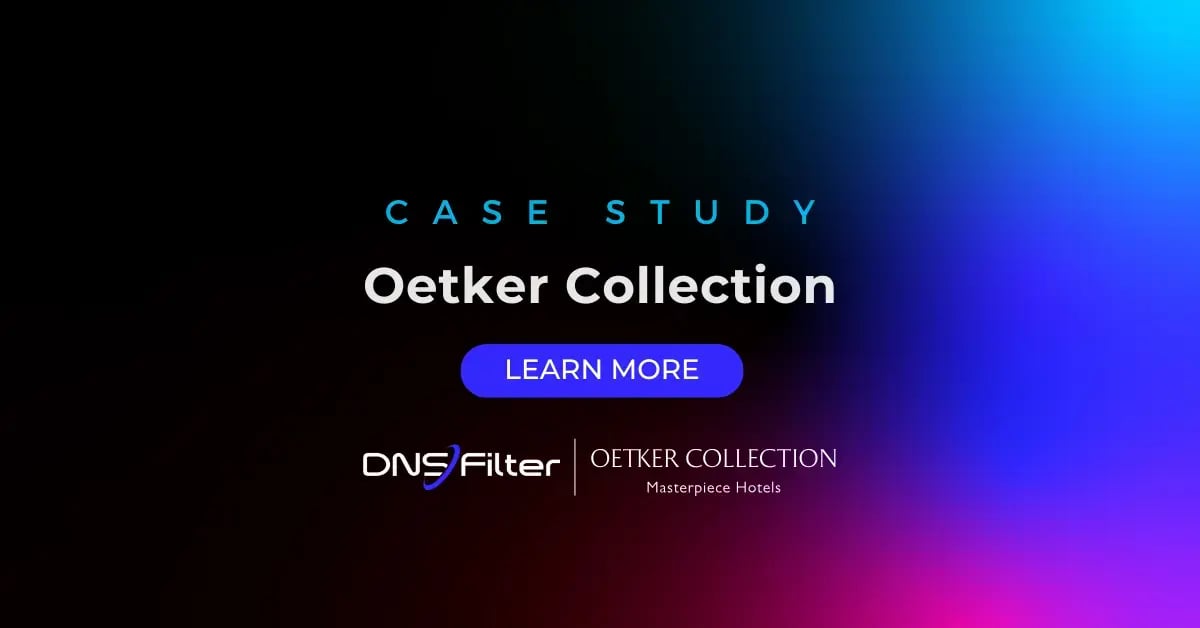
Oetker Collection Relies on DNSFilter to Stop Threats in Real Time
"After deciding his team couldn’t move forward with Cisco Umbrella, Florian turned to Reddit to read discussions about web filtering solutions. He found other IT professionals mentioning DNSFilter. He started his free trial, and shortly after signed."
Customers love us, threats hate us






.png?width=154&height=50&name=fresno%20(1).png)

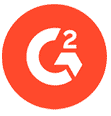






*Disclaimer: Offer valid for new customers switching from Cisco Umbrella who sign a qualifying DNSFilter contract by December 31, 2025. Terms and conditions apply. DNSFilter is not affiliated with or endorsed by Cisco Systems, Inc.



